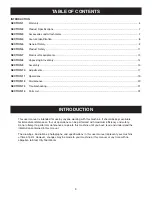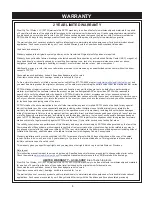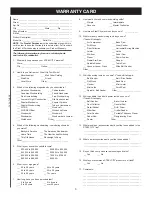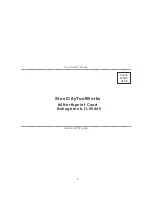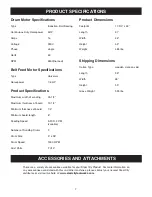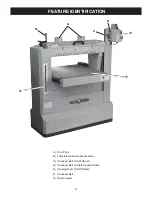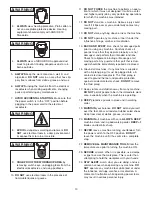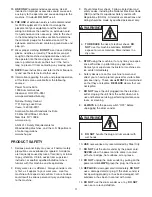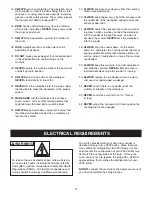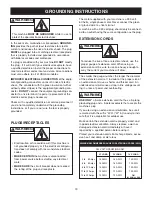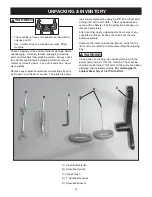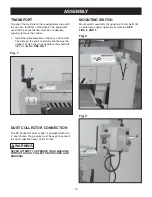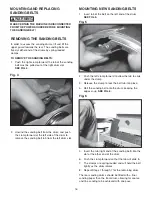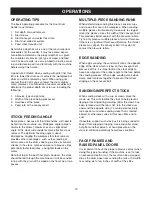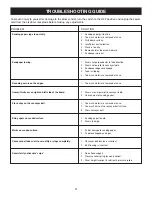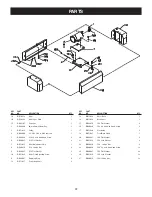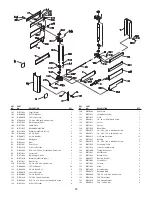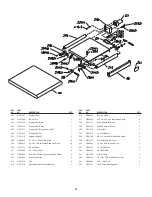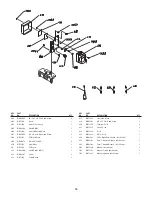
12
15.
ALWAYS
wear eye protection. The operation of any
drum sander can result in debris being thrown into
your eyes, causing severe eye damage. Everyday
glasses are not safety glasses. Wear safety glasses
that comply with ANSI standard Z87.1
16.
KEEP
hands and clothing away from the rotating
drum, belts and pulleys.
NEVER
place hands under
the drum or dust cover.
17.
ALWAYS
feed workpieces against the rotation of
the drum.
18.
HOLD
workpieces firmly and be aware of the
possibility of kickback.
19.
DO NOT
make passes deeper than recommended
in the specifications to avoid damage to the
machine.
20.
NEVER
operate the machine without the dust cover
and belt guard in position.
21.
ALWAYS
stand to one side of the workpiece;
NEVER
stand directly in line with it.
22.
NEVER
force the workpiece into the sander; allow
the feed belt to move the workpiece at the proper
speed.
23.
MAKE SURE
that the workpiece has no loose
knots, screws, nails or other foreign objects that
might damage the feed belt or sanding drum.
24.
ALWAYS
keep bystanders and yourself away from
the infeed and outfeed ends when a workpiece is
fed into the sander.
25.
ALWAYS
keep your hands away from the sanding
drums during operation.
26.
ALWAYS
keep fingers away from the conveyor and
the underside of the workpiece during sander and
conveyor operation.
27.
ALWAYS
adjust the conveyor feed rate and sand-
ing drum height, so when you feed the workpiece
into the sander using light pressure, you do not
overload the sander.
NEVER
force the workpiece
into the sander.
28.
ALWAYS
shut the sander down, let the drums
come to a complete stop, and disconnect power or
engage applicable safety-lock devices before you
service, adjust, troubleshoot, or leave the machine
unattended.
29.
ALWAYS
keep this machine in correct adjustment
and properly serviced.
NEVER
attempt to clear a
jammed workpiece while the sander is running.
30.
ALWAYS
replace the sandpaper when it is worn,
and use only undamaged sandpaper.
31.
NEVER
sand if there is any doubt about the
stability or integrity of the workpiece.
32.
NEVER
sand stock smaller than 1/4” thick or
6” long.
33.
NEVER
adjust the conveyor belt tracking when the
sanding drums are engaged.
ELECTRICAL REQUIREMENTS
To reduce the risk of electric shock, follow all electri-
cal and safety codes, including the National Electric
Code (NEC) and the Occupational Safety and Health
Regulations (OSHA). All electrical connections and
wiring should be made by qualified personnel only.
The switch provided with your dual drum sander is
designed to plug in to a 230V outlet. Since there are
many different configurations for 230V plugs, it is con-
ceivable that the configuration of your 230V outlet may
not match the configuration of the plug. If this is the
case, you will have to replace the plug with a UL/CSA
approved plug that matches the configuration of your
230V outlet.
DO NOT
connect the machine to the power source until
you have completed the setup process.
WARNING
!
Summary of Contents for 55220
Page 28: ......



